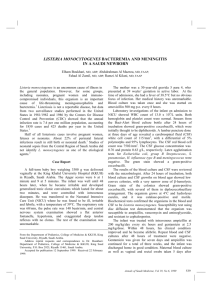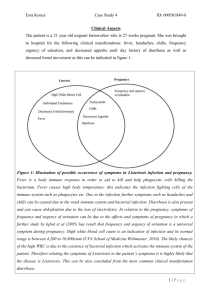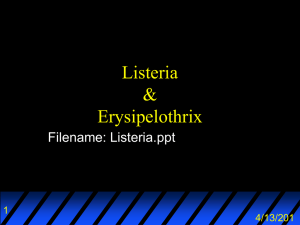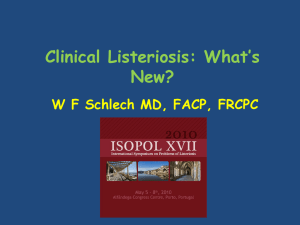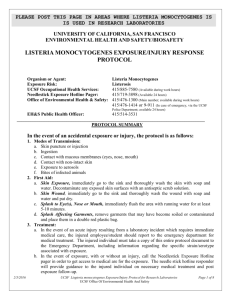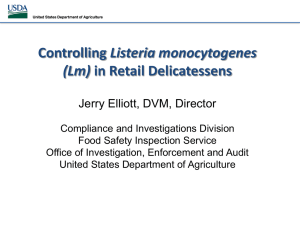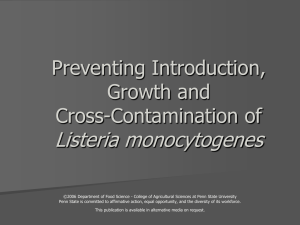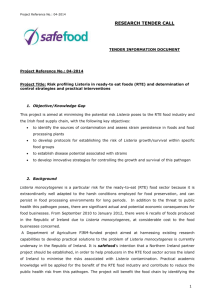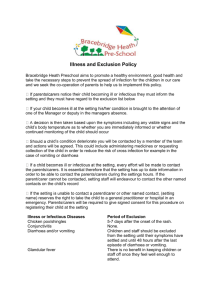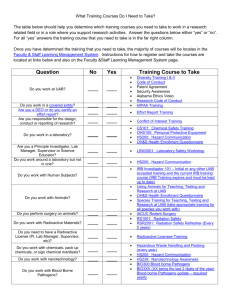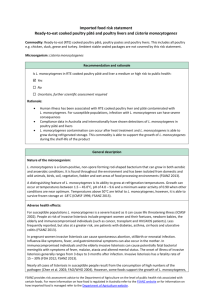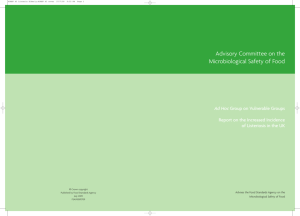Glandular listeriosis: Resembles infectious
advertisement
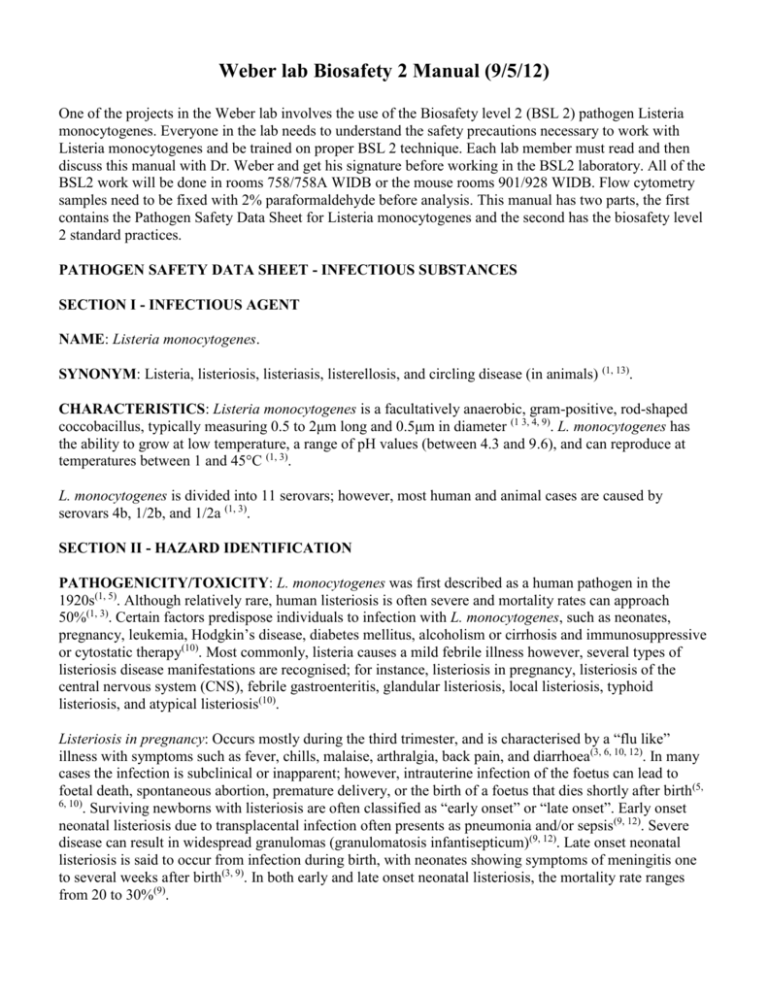
Weber lab Biosafety 2 Manual (9/5/12) One of the projects in the Weber lab involves the use of the Biosafety level 2 (BSL 2) pathogen Listeria monocytogenes. Everyone in the lab needs to understand the safety precautions necessary to work with Listeria monocytogenes and be trained on proper BSL 2 technique. Each lab member must read and then discuss this manual with Dr. Weber and get his signature before working in the BSL2 laboratory. All of the BSL2 work will be done in rooms 758/758A WIDB or the mouse rooms 901/928 WIDB. Flow cytometry samples need to be fixed with 2% paraformaldehyde before analysis. This manual has two parts, the first contains the Pathogen Safety Data Sheet for Listeria monocytogenes and the second has the biosafety level 2 standard practices. PATHOGEN SAFETY DATA SHEET - INFECTIOUS SUBSTANCES SECTION I - INFECTIOUS AGENT NAME: Listeria monocytogenes. SYNONYM: Listeria, listeriosis, listeriasis, listerellosis, and circling disease (in animals) (1, 13). CHARACTERISTICS: Listeria monocytogenes is a facultatively anaerobic, gram-positive, rod-shaped coccobacillus, typically measuring 0.5 to 2μm long and 0.5μm in diameter (1 3, 4, 9). L. monocytogenes has the ability to grow at low temperature, a range of pH values (between 4.3 and 9.6), and can reproduce at temperatures between 1 and 45°C (1, 3). L. monocytogenes is divided into 11 serovars; however, most human and animal cases are caused by serovars 4b, 1/2b, and 1/2a (1, 3). SECTION II - HAZARD IDENTIFICATION PATHOGENICITY/TOXICITY: L. monocytogenes was first described as a human pathogen in the 1920s(1, 5). Although relatively rare, human listeriosis is often severe and mortality rates can approach 50%(1, 3). Certain factors predispose individuals to infection with L. monocytogenes, such as neonates, pregnancy, leukemia, Hodgkin’s disease, diabetes mellitus, alcoholism or cirrhosis and immunosuppressive or cytostatic therapy(10). Most commonly, listeria causes a mild febrile illness however, several types of listeriosis disease manifestations are recognised; for instance, listeriosis in pregnancy, listeriosis of the central nervous system (CNS), febrile gastroenteritis, glandular listeriosis, local listeriosis, typhoid listeriosis, and atypical listeriosis(10). Listeriosis in pregnancy: Occurs mostly during the third trimester, and is characterised by a “flu like” illness with symptoms such as fever, chills, malaise, arthralgia, back pain, and diarrhoea(3, 6, 10, 12). In many cases the infection is subclinical or inapparent; however, intrauterine infection of the foetus can lead to foetal death, spontaneous abortion, premature delivery, or the birth of a foetus that dies shortly after birth(5, 6, 10) . Surviving newborns with listeriosis are often classified as “early onset” or “late onset”. Early onset neonatal listeriosis due to transplacental infection often presents as pneumonia and/or sepsis(9, 12). Severe disease can result in widespread granulomas (granulomatosis infantisepticum)(9, 12). Late onset neonatal listeriosis is said to occur from infection during birth, with neonates showing symptoms of meningitis one to several weeks after birth(3, 9). In both early and late onset neonatal listeriosis, the mortality rate ranges from 20 to 30%(9). Listeriosis of the CNS: Meningitis is the most frequently recognized listerial infection(6). Common symptoms of listeriosis of the CNS include high fever, nuchal rigidity, tremor and/or ataxia, and seizures (6) . The most common form of non-meningitic form of CNS listeriosis is encephalitis involving the brainstem (rhombencephalitis) (6). Febrile gastroenteritis: A non-invasive form of listeriosis that manifests as symptoms typical of gastroenteritis, for example, fever, diarrhoea, and vomiting(6, 9, 10). Glandular listeriosis: Resembles infectious mononucleosis with swelling of the salivary glands and nuchal lymph nodes(10). Local listeriosis: Can manifest as papules and pustules on the hands and arms following direct contact with infectious material, and can be accompanied by constitutional symptoms (fever, myalgia, and/or headache)(13). Typhoid listeriosis: Characterised by high fever and is particularly frequent in immunocompromised individuals(10). Atypical listeriosis: Rare cases of have been described with symptoms such as endocarditis, purulent (mononuclear) pleural exudates, pneumonia, urethritis, and abscesses(10). EPIDEMIOLOGY: Listeriosis occurs worldwide, but is seen mostly in industrialised countries(3, 4). Although L. monocytogenes was described as a human pathogen in the 1920s (mistakenly thought to be the cause of infectious mononucleosis), the first documented outbreak of food-borne listeriosis was in 1979 in 23 patients in a Boston hospital(3, 5). The first confirmed outbreak in Canada, and first definitive link of listeriosis cases to food, was in 1981 in the Maritime Provinces and was due to consumption of contaminated cabbage in coleslaw(5). Further outbreaks occurred during subsequent years and were often associated with a particular food type, from vegetable products in the early 1980s, to dairy products in the mid 1980s and early 1990s, to ready-to-eat meat and poultry products in the late 1990s to early 2000s(2, 5). Indeed, ready-to-eat meat and poultry products were responsible for a multi-state outbreak in the United States in 1999 that resulted in 101 cases of illness and 21 fatalities, and more recently in Canada (originating in North York, Ontario) in August 2008, resulting in 57 confirmed cases (mostly in Ontario) and 22 confirmed deaths(2, 7). HOST RANGE: L. monocytogenes has been isolated from many organisms, including humans and other mammals, fish, crustaceans, and insects(4, 10). INFECTIOUS DOSE: The approximate infective dose of L. monocytogenes is estimated to be 10 to 100 million colony forming units (CFU) in healthy hosts, and only 0.1 to 10 million CFU in individuals at high risk of infection(11). MODE OF TRANSMISSION: The predominant mode of L. monocytogenes transmission is by ingestion of contaminated food(1, 5, 10, 11). L. monocytogenes can also be transmitted transplacentally from mother to child during pregnancy and via the birth canal during birth(3, 9, 10, 12). Direct contact with diseased animals may lead to transmission to farmers and veterinarians during the birthing of domestic farm animals(13). Nosocomial infections and person-to-person transmission (excluding vertical) are recognised but rare(1). INCUBATION PERIOD: Can vary depending on the mode of transmission and dose received, but typically ranges from 1 to 4 weeks, and can be as high as several months(4, 10). Febrile gastroenteritis as a result of L. monocytogenes has a short incubation period, typically 18 to 20 hours(2, 9). COMMUNICABILITY: L. monocytogenes can be transmitted from mother to child during pregnancy and childbirth(3, 9, 10, 12). SECTION III - DISSEMINATION RESERVOIR: Soil, manure, decaying vegetable matter, silage, water, animal feed, fresh and frozen poultry, fresh and processed meats, raw milk, cheese, slaughterhouse waste, and asymptomatic human and animal carriers(4). ZOONOSIS: Yes, through consumption of foodstuffs containing infected animal products, manure contaminated vegetables, and by direct contact with animal tissues during birthing and butchering(1, 5, 9, 10, 13) . VECTORS: None. SECTION IV - STABILITY AND VIABILITY DRUG SUSCEPTIBILITY: Susceptible to most broad spectrum and gram-positive spectrum antibiotics, except the cephalosporins are active against L. monocytogenes in vitro(8). In vivo, the most active are ampicillin and amoxicillin(8). SUSCEPTIBILITY TO DISINFECTANTS: At room temperature, L. monocytogenes is susceptible to sodium hypochlorite, iodophor compounds, and quaternary ammonium compounds(14). Five to 10-fold higher concentrations of the above compounds are required at 4°C(14). PHYSICAL INACTIVATION: L. monocytogenes can be inactivated by ozone, high pressure (500MPa), and high temperatures (at least 70°C for 2 minutes)(14, 15). SURVIVAL OUTSIDE HOST: L. monocytogenes is commonly found in nature, particularly in association with soil, is relatively heat resistant, can tolerate cold temperature environments well, and can survive at low pH(9, 15). SECTION V – FIRST AID / MEDICAL SURVEILLANCE: Monitor for symptoms. Listeriosis can be diagnosed in the laboratory by cultivation of the organism, and demonstration of the infectious agent or its products in tissues or body fluids (1, 10). Several commercially available kits exist for the detection of L. monocytogenes. These rapid procedures are based on ELISA and PCR technology; however, none have been validated for use as a diagnostic tool (2, 4). FIRST AID/TREATMENT: Treatment for human listeriosis with ampicillin or amoxicillin together with gentamicin is the primary choice of therapy(8). The recommended course of treatment is ampicillin for 2 to 4 weeks(10). The addition of gentamicin for 2 weeks should be considered for immunocompromised patients(10). An alternative therapy for individuals allergic to β-lactams is intravenous co-trimoxazole(10). IMMUNIZATION: None currently available. PROPHYLAXIS: No chemoprophylaxis exists; however, precautions for individuals who are immunocompromised or pregnant women include the avoidance of raw food and vegetables, undercooked meat, soft cheeses, and cheeses prepared from unpasteurised milk(10). SECTION VI - LABORATORY HAZARDS LABORATORY-ACQUIRED INFECTIONS: A particularly rare laboratory-acquired infection with some suspected cases, none of which have been confirmed(16). SOURCES/SPECIMENS: Blood, cerebrospinal fluid, faeces, placenta, skin lesions, pus, amniotic fluid, menstrual blood, lochia, respiratory secretions, meconium, gastric aspirate, animal tissues/specimens, and infected organs such as brain and liver(2, 4, 10). PRIMARY HAZARDS: Accidental autoinoculation, exposure to the tissues of experimentally infected animals, and L. monocytogenes cultures(17). SPECIAL HAZARDS: Those at greater risk of infection (pregnant women or immunocompromised individuals) should take extra care when working in a laboratory where L. monocytogenes is propagated or handled(3). SECTION VII – EXPOSURE CONTROLS / PERSONAL PROTECTION RISK GROUP CLASSIFICATION: Risk Group 2(18). CONTAINMENT REQUIREMENTS: Containment Level 2 facilities, equipment, and operational practices for work involving infectious or potentially infectious material, animals, or cultures. PROTECTIVE CLOTHING: Lab coat. Gloves when direct skin contact with infected materials or animals is unavoidable(17). Eye protection must be used where there is a known or potential risk of exposure to splashes. OTHER PRECAUTIONS: All procedures that may produce aerosols, or involve high concentrations or large volumes should be conducted in a biological safety cabinet (BSC)(17). The use of needles, syringes, and other sharp objects should be strictly limited. Additional precautions should be considered with work involving animals or large scale activities. SECTION VIII – HANDLING AND STORAGE SPILLS: Allow aerosols to settle and, wearing protective clothing, gently cover spill with paper towels and apply an appropriate disinfectant, starting at the perimeter and working towards the center. Allow sufficient contact time before clean up(17). DISPOSAL: Decontaminate all wastes that contain or have come in contact with the infectious organism before disposing by autoclave, chemical disinfection, gamma irradiation, or incineration(17). STORAGE: The infectious agent should be stored in leak-proof containers that are appropriately labelled(17). SECTION IX - REGULATORY AND OTHER INFORMATION UPDATED: December 2011 PREPARED BY: Pathogen Regulation Directorate, Public Health Agency of Canada. Although the information, opinions and recommendations contained in this Pathogen Safety Data Sheet are compiled from sources believed to be reliable, we accept no responsibility for the accuracy, sufficiency, or reliability or for any loss or injury resulting from the use of the information. Newly discovered hazards are frequent and this information may not be completely up to date. Copyright © Public Health Agency of Canada, 2011 Canada REFERENCES: 1. 2. 3. 4. 5. 6. 7. 8. 9. 10. 11. 12. 13. 14. 15. 16. 17. 18. Low, J. C., & Donachie, W. (1997). A review of Listeria monocytogenes and listeriosis. Veterinary Journal, 153(1), 9-29. Donnelly, C. W. (2001). Listeria monocytogenes: A continuing challenge. Nutrition Reviews, 59(6), 183-194. Acha, P. N., & Szyfres, B. (2003). Listeriosis. Zoonoses and Communicable Diseases Common to Man and Animals (3rd ed., pp. 168-179). Washington D.C.: Pan American Health Organization. Bille, J., Rocourt, J., & Swaminathan, B. (2003). Listeria and Erysipelothrix. In P. R. Murray, E. J. Baron, J. H. Jorgensen, M. A. Pfaller & R. H. Yolken (Eds.), Manual of Clinical Microbiology (8th ed., pp. 461-471). Washington, D.C.: ASM Press. Gahan, C. G. M., & Hill, C. (2005). Gastrointestinal phase of Listeria monocytogenes infection. Journal of Applied Microbiology, 98(6), 1345-1353. Doganay, M. (2003). Listeriosis: Clinical presentation. FEMS Immunology and Medical Microbiology, 35(3), 173-175. Public Health Agency of Canada. (2008). Listeria monocytogenes outbreak.http://www.phac-aspc.gc.ca/alertalerte/listeria/listeria_2008-eng.php Hof, H. (1991). Therapeutic activities of antibiotics in Listeriosis. Infection, 19(SUPPL. 4), S229-S233. Roberts, A. J., & Wiedmann, M. (2003). Pathogen, host and environmental factors contributing to the pathogenesis of listeriosis. Cellular and Molecular Life Sciences, 60(5), 904-918. Krauss, H., Schiefer, H. G., Weber, A., Slenczka, W., Appel, M., von Graevenitz, A., Enders, B., Zahner, H., & Isenberg, H. D. (2003). Bacterial Zoonoses. Zoonoses: Infectious Diseases Transmissible from Animals to Humans (3rd ed., pp. 205-208). Washington, D.C.: ASM Press. Farber, J. M., Ross, W. H., & Harwig, J. (1996). Health risk assessment of Listeria monocytogenes in Canada. International Journal of Food Microbiology, 30(1-2), 145-156. Mylonakis, E., Paliou, M., Hohmann, E. L., Calderwood, S. B., & Wing, E. J. (2002). Listeriosis during pregnancy: A case series and review of 222 cases. Medicine, 81(4), 260-269. Regan, E. J., Harrison, G. A. J., Butler, S., McLauchlin, J., Thomas, M., & Mitchell, S. (2005). Primary cutaneous listeriosis in a veterinarian [2]. Veterinary Record, 157(7), 207. Mafu, A. A., Roy, D., Goulet, J., Savoie, L., & Roy, R. (1990). Efficiency of sanitizing agents for destroying Listeria monocytogenes on contaminated surfaces. Journal of Dairy Science, 73(12), 3428-3432. Gaze, J. E., Brown, G. D., Gaskell, D. E., & Banks, J. G. (1989). Heat resistance of Listeria monocytogenes in homogenates of chicken, beef steak and carrot. Food Microbiology, 6(4), 251-259. Collins, C. H., & Kennedy, D. A. (1999). Laboratory acquired infections. Laboratory acquired infections: History, incidence, causes and preventions (4th ed., pp. 1-37). Woburn, MA: Butterworth-Heinemann. Public Health Agency of Canada. (2004). In Best B., Graham M. L., Leitner R., Ouellette M. and Ugwu K. (Eds.), Laboratory Biosafety Guidelines (3rd ed.). Canada: Public Health Agency of Canada. Human pathogens and toxins act. S.C. 2009, c. 24, Second Session, Fortieth Parliament, 57-58 Elizabeth II, 2009. (2009). Biosafety Level 2 Biosafety Level 2 builds upon BSL-1. BSL-2 is suitable for work involving agents that pose moderate hazards to personnel and the environment. It differs from BSL-1 in that 1) laboratory personnel have specific training in handling pathogenic agents and are supervised by scientists competent in handling infectious agents and associated procedures; 2) access to the laboratory is restricted when work is being conducted; and 3) all procedures in which infectious aerosols or splashes may be created are conducted in BSCs or other physical containment equipment. The following standard and special practices, safety equipment, and facility requirements apply to BSL-2: A. Standard Microbiological Practices 1. The laboratory supervisor must enforce the institutional policies that control access to the laboratory. 2. Persons must wash their hands after working with potentially hazardous materials and before leaving the laboratory. 3. Eating, drinking, smoking, handling contact lenses, applying cosmetics, and storing food for human consumption must not be permitted in laboratory areas. Food must be stored outside the laboratory area in cabinets or refrigerators designated and used for this purpose. 4. Mouth pipetting is prohibited; mechanical pipetting devices must be used. 5. Policies for the safe handling of sharps, such as needles, scalpels, pipettes, and broken glassware must be developed and implemented. Whenever practical, laboratory supervisors should adopt improved engineering and work practice controls that reduce risk of sharps injuries. Precautions, including those listed below, must always be taken with sharp items. These include: a. Careful management of needles and other sharps are of primary importance. Needles must not be bent, sheared, broken, recapped, removed from disposable syringes, or otherwise manipulated by hand before disposal. b. Used disposable needles and syringes must be carefully placed in conveniently located puncture-resistant containers used for sharps disposal. c. Non-disposable sharps must be placed in a hard walled container for transport to a processing area for decontamination, preferably by autoclaving. d. Broken glassware must not be handled directly. Instead, it must be removed using a brush and dustpan, tongs, or forceps. Plasticware should be substituted for glassware whenever possible. 6. Perform all procedures to minimize the creation of splashes and/or aerosols. 7. Decontaminate work surfaces after completion of work and after any spill or splash of potentially infectious material with appropriate disinfectant. 8. Decontaminate all cultures, stocks, and other potentially infectious materials before disposal using an effective method. Depending on where the decontamination will be performed, the following methods should be used prior to transport: a. Materials to be decontaminated outside of the immediate laboratory must be placed in a durable, leak proof container and secured for transport. b. Materials to be removed from the facility for decontamination must be packed in accordance with applicable local, state, and federal regulations. 9. A sign incorporating the universal biohazard symbol must be posted at the entrance to the laboratory when infectious agents are present. Posted information must include: the laboratory’s biosafety level, the supervisor’s name (or other responsible personnel), telephone number, and required procedures for entering and exiting the laboratory. Agent information should be posted in accordance with the institutional policy. 10. An effective integrated pest management program is required. See Appendix G. 11. The laboratory supervisor must ensure that laboratory personnel receive appropriate training regarding their duties, the necessary precautions to prevent exposures, and exposure evaluation procedures. Personnel must receive annual updates or additional training when procedural or policy changes occur. Personal health status may impact an individual’s susceptibility to infection, ability to receive immunizations or prophylactic interventions. Therefore, all laboratory personnel and particularly women of child-bearing age should be provided with information regarding immune competence and conditions that may predispose them to infection. Individuals having these conditions should be encouraged to self-identify to the institution’s healthcare provider for appropriate counseling and guidance. B. Special Practices 1. All persons entering the laboratory must be advised of the potential hazards and meet specific entry/exit requirements. 2. Laboratory personnel must be provided medical surveillance and offered appropriate immunizations for agents handled or potentially present in the laboratory. 3. When appropriate, a baseline serum sample should be stored. 4. A laboratory-specific biosafety manual must be prepared and adopted as policy. The biosafety manual must be available and accessible. 5. The laboratory supervisor must ensure that laboratory personnel demonstrate proficiency in standard and special microbiological practices before working with BSL-2 agents. 6. Potentially infectious materials must be placed in a durable, leak proof container during collection, handling, processing, storage, or transport within a facility. 7. Laboratory equipment should be routinely decontaminated, as well as, after spills, splashes, or other potential contamination. a. Spills involving infectious materials must be contained, decontaminated, and cleaned up by staff properly trained and equipped to work with infectious material. b. Equipment must be decontaminated before repair, maintenance, or removal from the laboratory. 8. Incidents that may result in exposure to infectious materials must be immediately evaluated and treated according to procedures described in the laboratory biosafety safety manual. All such incidents must be reported to the laboratory supervisor. Medical evaluation, surveillance, and treatment should be provided and appropriate records maintained. 9. Animals and plants not associated with the work being performed must not be permitted in the laboratory. 10. All procedures involving the manipulation of infectious materials that may generate an aerosol should be conducted within a BSC or other physical containment devices. C. Safety Equipment (Primary Barriers and Personal Protective Equipment) 1. Properly maintained BSCs (preferably Class II), other appropriate personal protective equipment, or other physical containment devices must be used whenever: a. Procedures with a potential for creating infectious aerosols or splashes are conducted. These may include pipetting, centrifuging, grinding, blending, shaking, mixing, sonicating, opening containers of infectious materials, inoculating animals intranasally, and harvesting infected tissues from animals or eggs. b. High concentrations or large volumes of infectious agents are used. Such materials may be centrifuged in the open laboratory using sealed rotor heads or centrifuge safety cups. 2. Protective laboratory coats, gowns, smocks, or uniforms designated for laboratory use must be worn while working with hazardous materials. Remove protective clothing before leaving for non-laboratory areas (e.g., cafeteria, library, administrative offices). Dispose of protective clothing appropriately, or deposit it for laundering by the institution. It is recommended that laboratory clothing not be taken home. 3. Eye and face protection (goggles, mask, face shield or other splatter guard) is used for anticipated splashes or sprays of infectious or other hazardous materials when the microorganisms must be handled outside the BSC or containment device. Eye and face protection must be disposed of with other contaminated laboratory waste or decontaminated before reuse. Persons who wear contact lenses in laboratories should also wear eye protection. 4. Gloves must be worn to protect hands from exposure to hazardous materials. Glove selection should be based on an appropriate risk assessment. Alternatives to latex gloves should be available. Gloves must not be worn outside the laboratory. In addition, BSL-2 laboratory workers should: a. Change gloves when contaminated, integrity has been compromised, or when otherwise necessary. Wear two pairs of gloves when appropriate. b. Remove gloves and wash hands when work with hazardous materials has been completed and before leaving the laboratory. c. Do not wash or reuse disposable gloves. Dispose of used gloves with other contaminated laboratory waste. Hand washing protocols must be rigorously followed. 5. Eye, face and respiratory protection should be used in rooms containing infected animals as determined by the risk assessment. D. Laboratory Facilities (Secondary Barriers) 1. Laboratory doors should be self-closing and have locks in accordance with the institutional policies. 2. Laboratories must have a sink for hand washing. The sink may be manually, hands-free, or automatically operated. It should be located near the exit door. 3. The laboratory should be designed so that it can be easily cleaned and decontaminated. Carpets and rugs in laboratories are not permitted. 4. Laboratory furniture must be capable of supporting anticipated loads and uses. Spaces between benches, cabinets, and equipment should be accessible for cleaning. a. Bench tops must be impervious to water and resistant to heat, organic solvents, acids, alkalis, and other chemicals. b. Chairs used in laboratory work must be covered with a non-porous material that can be easily cleaned and decontaminated with appropriate disinfectant. 5. Laboratory windows that open to the exterior are not recommended. However, if a laboratory does have windows that open to the exterior, they must be fitted with screens. 6. BSCs must be installed so that fluctuations of the room air supply and exhaust do not interfere with proper operations. BSCs should be located away from doors, windows that can be opened, heavily traveled laboratory areas, and other possible airflow disruptions. 7. Vacuum lines should be protected with High Efficiency Particulate Air (HEPA) filters or their equivalent. Filters must be replaced as needed. Liquid disinfectant traps may be required. 8. An eyewash station must be readily available. 9. There are no specific requirements on ventilation systems. However, planning of new facilities should consider mechanical ventilation systems that provide an inward flow of air without recirculation to spaces outside of the laboratory. 10. HEPA filtered exhaust air from a Class II BSC can be safely re-circulated back into the laboratory environment if the cabinet is tested and certified at least annually and operated according to manufacturer’s recommendations.BSCs can also be connected to the laboratory exhaust system by either a thimble (canopy) connection or a direct (hard) connection. Provisions to assure proper safety cabinet performance and air system operation must be verified. 11. A method for decontaminating all laboratory wastes should be available in the facility (e.g., autoclave, chemical disinfection, incineration, or other validated decontamination. I have read this biosafety manual and agree to follow the biosafety level 2 rules. Lab member Date Supervisors signature Date
